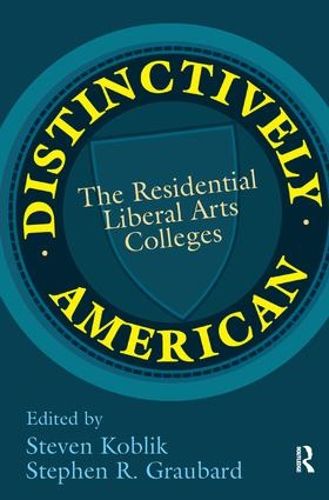Readings Newsletter
Become a Readings Member to make your shopping experience even easier.
Sign in or sign up for free!
You’re not far away from qualifying for FREE standard shipping within Australia
You’ve qualified for FREE standard shipping within Australia
The cart is loading…






There is much change underway in American higher education. New technologies are challenging the teaching practices of yesterday, distance learning is lauded, and private firms offer to certify the educational credentials that businesses and others will deem satisfactory. In this new environment, America’s liberal arts colleges propound a quite different set of values. Their continuing faith in the liberal arts–not as the nineteenth century chose to define them but as the twenty-first century will be obliged to reconsider them–is being tested.
Distinctively American examines the American liberal arts college as an institution, from its role in the lives of students, to its value as a form of education. It explores the threats faced by liberal arts colleges as well as the transformative role, both positive and negative, information technology will play in their future development and survival. In the preface introducing the volume, Stephen Graubard examines the history of the American liberal arts colleges, from their early disdained reputations in comparison to European schools, to their slow rise to becoming world-class universities.
This important volume explores the triumphs and challenges of one segment of the American higher educational universe. It also addresses a larger question: What ought this country be teaching its young, the many millions who now throng its colleges and universities? Distinctively American is essential reading for all concerned with the future of higher education.
$9.00 standard shipping within Australia
FREE standard shipping within Australia for orders over $100.00
Express & International shipping calculated at checkout
There is much change underway in American higher education. New technologies are challenging the teaching practices of yesterday, distance learning is lauded, and private firms offer to certify the educational credentials that businesses and others will deem satisfactory. In this new environment, America’s liberal arts colleges propound a quite different set of values. Their continuing faith in the liberal arts–not as the nineteenth century chose to define them but as the twenty-first century will be obliged to reconsider them–is being tested.
Distinctively American examines the American liberal arts college as an institution, from its role in the lives of students, to its value as a form of education. It explores the threats faced by liberal arts colleges as well as the transformative role, both positive and negative, information technology will play in their future development and survival. In the preface introducing the volume, Stephen Graubard examines the history of the American liberal arts colleges, from their early disdained reputations in comparison to European schools, to their slow rise to becoming world-class universities.
This important volume explores the triumphs and challenges of one segment of the American higher educational universe. It also addresses a larger question: What ought this country be teaching its young, the many millions who now throng its colleges and universities? Distinctively American is essential reading for all concerned with the future of higher education.